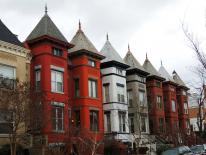
'Live Near Your Work' Pilot Program Description
‘Live Near Your Work’ is a type of Employer Assisted Housing (EAH) program under development by the DC Office of Planning (OP) to not only support an employee toward buying a home, but encourage them to live closer to their job. The ‘Live Near Your Work’ (LNYW) program proposal is a matching homeownership grant for down-payment and closing cost assistance in partnership between the District of Columbia and participating employers within the city. The District will match contributions made by the employer up to $8,000 to attract and retain DC residents, with the primary purpose of encouraging employees to live close to their place of employment and/or transit. The pilot program encourages prospective homebuyers to live within walking and/or transit distance to their place of employment in order to reduce not only household travel and energy costs, but to reduce the impact of long commutes on roads, congestion, and air quality.
The program is initially targeted towards the employees of large employers in the District, such as the federal government, major universities and health-hospital campuses in order to have significant impact on commuting levels (since many workers might be eligible for such a program), and to allow employers to offer the program as a tradeoff for employee parking or other commuter benefits.
‘Live Near Your Work’ can be tailored to meet specific partner goals, but the program has the following basic components:
- The District of Columbia will match (up to $8,000) contributions made by the employer toward assisting an employee’s purchase of a home within the city, and close to transit or their place of employment.
- The program is open to households of all income.
- The home must be their primary residence and located in the District and within 2.0 miles of their place of employment, or 0.5 miles of a metro station, or 0.25 miles of a high-quality bus route.
- Matching amounts are expected to vary by employer, and could range from $4,000 up to $8,000. The program is currently budgeted to assist between 25-50 participant households.
- Contributions from employers must be in the form of a grant or a 0% deferred loan that is repayable at the time of payoff, refinance, or upon the sale or transfer of the house.
Program Alternatives
- A tier system of grants to encourage housing in specific neighborhoods or other partner goals.
- Employers could also contribute towards alternative transport incentives, such as pre-tax SmartTrip transit benefits, Zipcar credits, and Capital Bikeshare membership.
Program Evaluation and Benefits
The pilot program will include a cost-benefit study to evaluate the value of LNYW to the reduction of vehicle miles traveled, employer benefits, and to District revenues with the goal of expanding the program with additional local funds. Similar studies have documented many different types of benefits that accrue to the employee, the employer, the city and the region.
Employee Benefits
Approximately 54.0 percent of workers in the Washington Metropolitan Region drive more than 30 minutes to work, but employees who live within 1.5 miles or less of their job can walk to work in less than 30 minutes or drive in less than 5 minutes. This can save the employee more than $3,000 per year in transportation costs. If the house location is also near metro or a pedestrian friendly neighborhood, the savings can more than double to $7,000 per year. Unfortunately, most mortgage products do not recognize the savings in transportation costs when calculating how much a household can afford.
Employer Benefits
Employers benefit in several ways when employees can live close to work. A study conducted by the Center for Housing Policy found that employees who participated in the Aurora Health Care EAH program in Milwaukee received higher performance evaluations and had lower rates of turnover. The potential benefits also include improved day-to-day on-time attendance, greater probability of attendance in adverse or emergency conditions, and the potential health benefits to employees who are able to walk or bike to work.
An EAH program like ‘Live Near Your Work’ can also be a useful recruitment tool particularly in areas where housing costs are perceived as high. In addition, they are less costly and subsidize housing with lower risk than other housing programs such as constructing dedicated faculty/staff housing.Non-housing commuting programs like an employee parking subsidy program can cost the employer as much as $10,000 dollars over five years with little documented benefit to employee performance.
Local and Regional Benefits
Neighborhoods, local governments and the region all benefit when employees can live closer to work. LNYW provide neighborhoods a stable base of homeowners. Focused efforts like the University of Chicago’s or Howard University’s LeDroit Park effort can help catalyze investment to improve neighborhood quality and safety. Local governments and the region benefit from reduced wear and tear on streets, reduced traffic congestion, improved air quality and lower carbon emissions.
For further information, contact Art Rodgers, Senior Housing Planner, DC Office of Planning at (202) 442-7600 or by email at [email protected]


